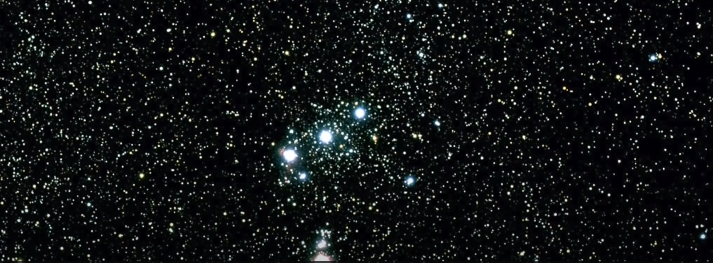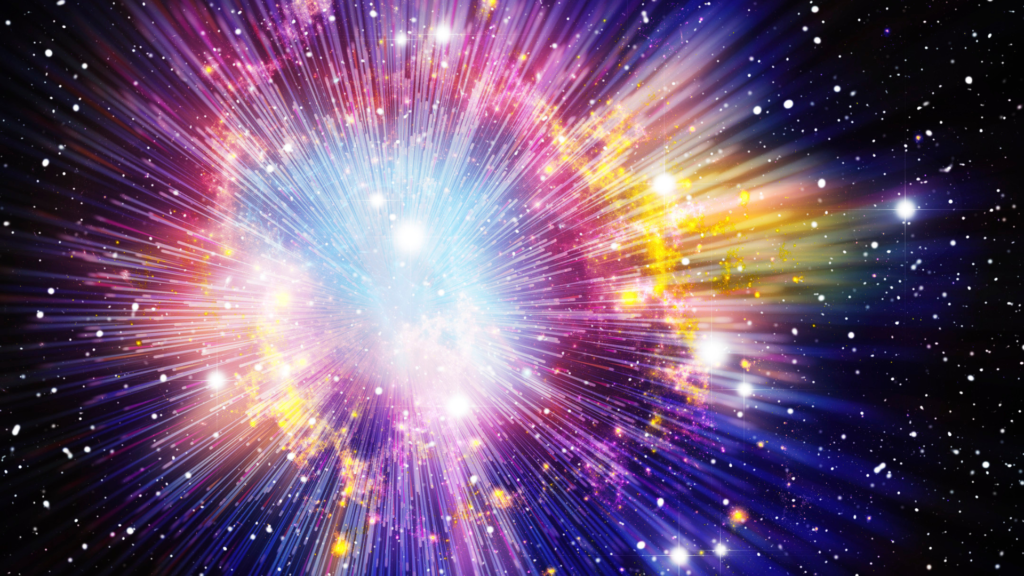Up to now you must have seen many beautiful images of the James Webb space telescope. And by now you must be knowing that James Webb space telescope work in infrared and it detects the dust when it glows. One question arise is where did this dust come from and why is our universe so dusty?
Actually What is Dust?
There is no shortage of dust (which is also called mud, dirt, soil, soot whatever you say or sand) on this earth. We have to clean up the house and dusting is done to remove this dust. Most of the dust at home is made up of dead cells of your skin which have fallen off. Besides pollen from flowers and plants as you come into the house as dust and soil etc can also from outside. Now this was about earth. Dust is also present in space.
Dust in Space
- The tail of the comet is made when some evaporation takes place in its main nucleus in the shape of dust and that dust forms its tail.
- Similarly, on Mars (where some rovers and also present nowadays) do you know huge dust storms occur there.
- Then in our own solar system dust particle are present in the space between the planets.
- One thing is called Zodiacal light. The light produced when sun light is reflected or scattered by Deez. Dust particles is called Zodiacal light. So dust is present in the space between the planets in our solar system.
Then when we see towards the center of our galaxy (the Milky Way) specially in summer we cannot see some stars. This is not so because no stars are present there, but that reason for this is that the light of those stars is blocked by the nebula or dust clouds present in our own galaxy.
Dusty Galaxies
And then on a large scale, dust is present in galaxies (as in our Milky Way) but from the list galaxies at the beginning of our universe, (this was discovered by astronomers in late 90’s and early 2000) are so dusty that they are not seen in visible light, delight, to which our eyes are sensitive but they’re ready eight in infrared other wavelength sub millimeters etc.
Now these galaxies are extremely dust and a large number of stars are also farming here. Astronomers call these galaxies “dusty galaxies”.
Importance of Dust in space
We are taking so much about dust because this has an important in space. Do not dust it off just like that. In fact you and would not be here if there is no dust in space. For example in center of the star farming region (Nebula) one the dust decrease the temperature

In the beginning, due to which collapse can start which leads to formation of stars. This is very important for sun like stars. Van collapse starts in these gas clouds for the formation of big stars, there is a lot of ultraviolet radiation. Distribution of these big stars stops the formation of other stars. It starts to evaporate the material near it (of other stars). But if dust is present around it (other stars) this blocks, that ultraviolet light and small stars (relatively) like our sun can also form.
Then when your sun is forming it is called protostar. Around it there is a disc called protoplanetary disk. These are dust particle in it. They are the same particles are present on this earth. They start mixing with one another, because of which a seed is formed around witch a planet is formed

Then we talk about the origin of our Earth its roots, is the dust, which was present in the Proto planetary disk. Now what is the dust, president in space, made of?
Which thing, Dust made of?
Actually, this is a combination of carbon molecule or silicates. This is very small less than hundred times thickness of our hair. This is its size. The most available variety and it is not one type of dust, different type of dust are found in it. The most common are called “POLYCYCLIC AROMATIC HYDROCARBONS (PAH’s)”.
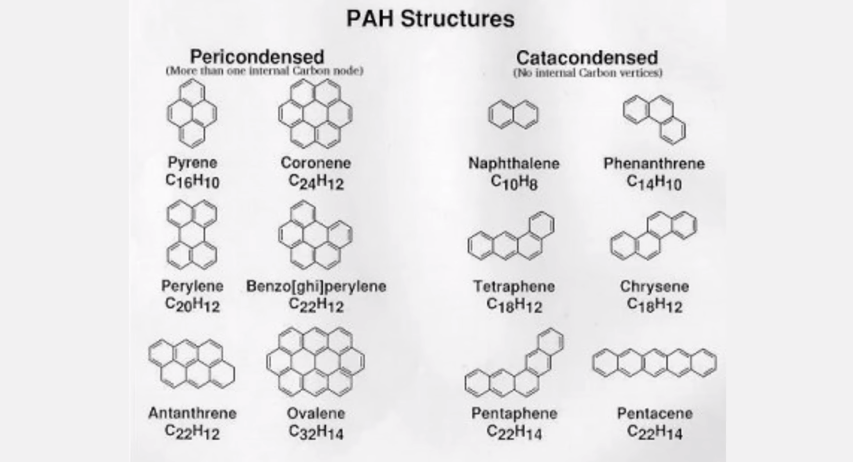
These are a sort of chain molecules, these are hydrocarbons as the name says it has hydrogen and it has carbon in it and they make different type of chains. These PAH’s you can see them as soot. If these PAH’s or POLYCYCLIC AROMATIC HYDROCARBONS in space have no connection with soot then how are they formed. We will talk about this at the end of the article but first let us see how to detect this dust the molecules we are taking about.
How to detect dust in space?
If you see the Milky Way in the sky especially in summer the place where you do not see stars, there is a lane of clusters of stars but you see some dark spots. You can see there are nebula, dust clouds at that place which are absorbing the light of the stars. This is one way of detecting dust, indirectly.
But when this test gets hot, we talked about ultraviolet radiation of stars the dust molecules absorb the light and then they radiate it again and that they radiate in infrared.
Now its connection has come to James Webb space telescope which works in infrared. The James Webb space telescope detects the dust in infrared when it is heated and when it glows. All this infrared is not only because of dust rather infrared is a big spectrum in which the contribution of the stars also is there. One instrument of James Webb space telescope works in near infrared.
Near infrared if you want technical details, that works in approximately from 1 micron to 4 and half microns. The light of the stars is in it and it detects some dust, which gets heated up due to the light of the big stars. If you see with near infra-cam the image is mostly of the light of stars and a little of dust.
There is another camera mid infrared. This mid infrared instrument works between 7 micron to 18 micron. This is the ideal place where you can detect polycyclic aromatic hydrocarbons PAH’s and on this wavelength the contribution of the stars is very little, it is negligible. If you want to detect the dust probably the mid infrared is a good place.
NGC 7496

Now you see a picture of a galaxy this is NGC 7496. NGC is the name of catalogue and this is 7496th object in that catalogue. This is about 24 million light years away from us and astronomers say it is a nearby galaxy. The image is in visible light of the Hubble space telescope. Here are the light of all stars is visible as yellowish or orangish color and the blue coloured stars you can see are relatively young stars.
Second thing is the spiral arms there are mostly young stars and they dominate the spiral arms and because these youngsters are big and have relatively less life they tell us new stars are forming here.
Here you can see same dust lanes also in visible. A little bit of dust can also be seen there. Now let’s put on the switch of James Webb space telescope.

Now you are seeing this infrared. This is the wavelength in which stars do not contribute much. On this wavelength the things you are seeing is simply dust and you can see the distribution of the dust, which was heated up due to the light of the stars. You can also see some clumps in it. This is that place (molecular clouds), these clouds are where probably new stars are forming, normally you cannot see inside these clumps because dust absorbs the visible light but here you can see the things inside it.
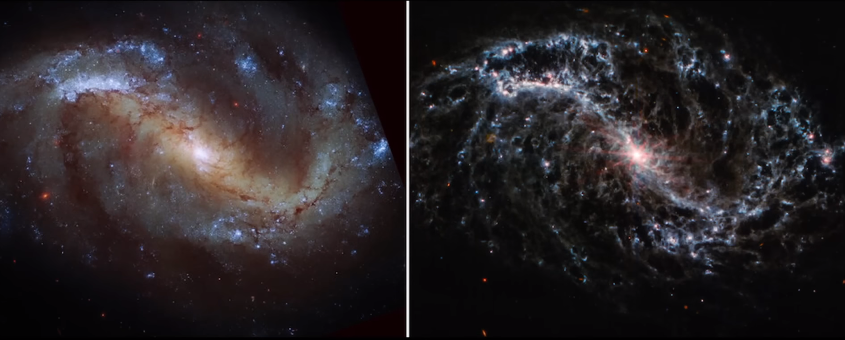
Let me find out that Infrared telescope, some telescopes and some satellites have previously been working in infrared, but the resolution meaning the fine detail, this is the marvel of the James Webb space telescope that it can see the dust in such detail.
Where is this dust formed?
We do not know about this. This is a mystery for astronomers. Up-till now our assumption is, then the end stage of the stars (as our sun) will come it will go through a red giant phase. The atmosphere of the red giant will be relatively cooler. This does not mean freezing temperature, is the temperature will be a few thousand degree. Nowadays the surface temperature of our sun is 6000° compared to this it will be less.
Astronomers think that this type of Outer envelopes of red giants is a specific phase towards the end life of stars. At that time these dust particles combine and they make this Polycyclic Aromatic Hydrocarbons or silicates.
Dust found in Super Giant Star
We also have evidence that that is made in the big stars where they become red super giants. Few years before Betelgeuse the favorite star of many people, its brightness suddenly diminished.
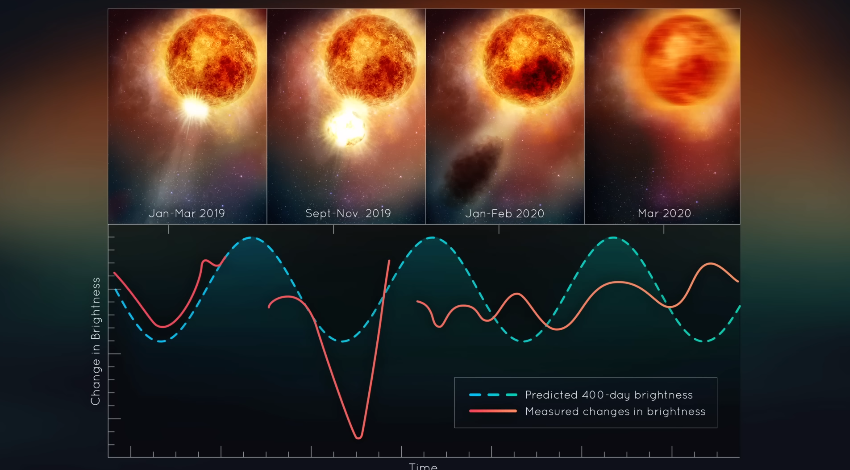
This Betelgeuse is in the last stage of life, and it is a red super giant. This type of dust in a large quantity. It is assumed the light of betelgeuse diminished because its own dust cloud (the dust it made) blocked its light.
Now astronomers thing that large molecule (dust) of this type is made in the outer parts (which are relatively cool) of the stars when they are in the red giant phase. The idea is most of the dust of the dusty galaxies of the beginning was made through supernova.
